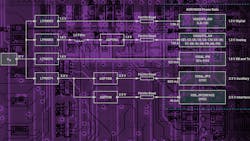Optimizing Power Systems for the Signal Chain (Part 3) (Download)
Part 1 of this signal-chain power-optimization series discusses how power-supply noise can be quantified to identify its effect on various parameters of signal-chain devices. An optimized power distribution network (PDN) can be created by determining the actual noise limits the signal-processing devices can accept without affecting the integrity of the signals they produce. In Part 2, this methodology is applied to high-speed analog-to-digital and digital-to-analog converters, where it demonstrates that lowering noise to a necessary level doesn’t always equate to higher cost, increased sized, and lower efficiency. These design parameters can actually be met in one optimized power solution.
This third and final part of the series focuses on another part of the signal chain—RF transceivers. Here, we check the sensitivity of the device to the noise coming from each power rail to identify those that need additional noise filtering. An optimized power solution is provided, which is further validated by comparing its spurious-free dynamic-range (SFDR) and phase-noise performance to the current PDN when attached to the RF transceiver.
